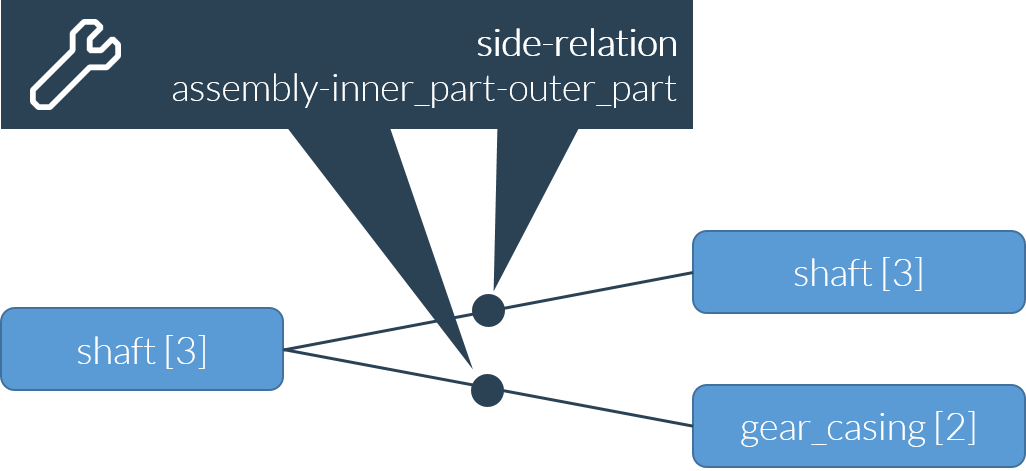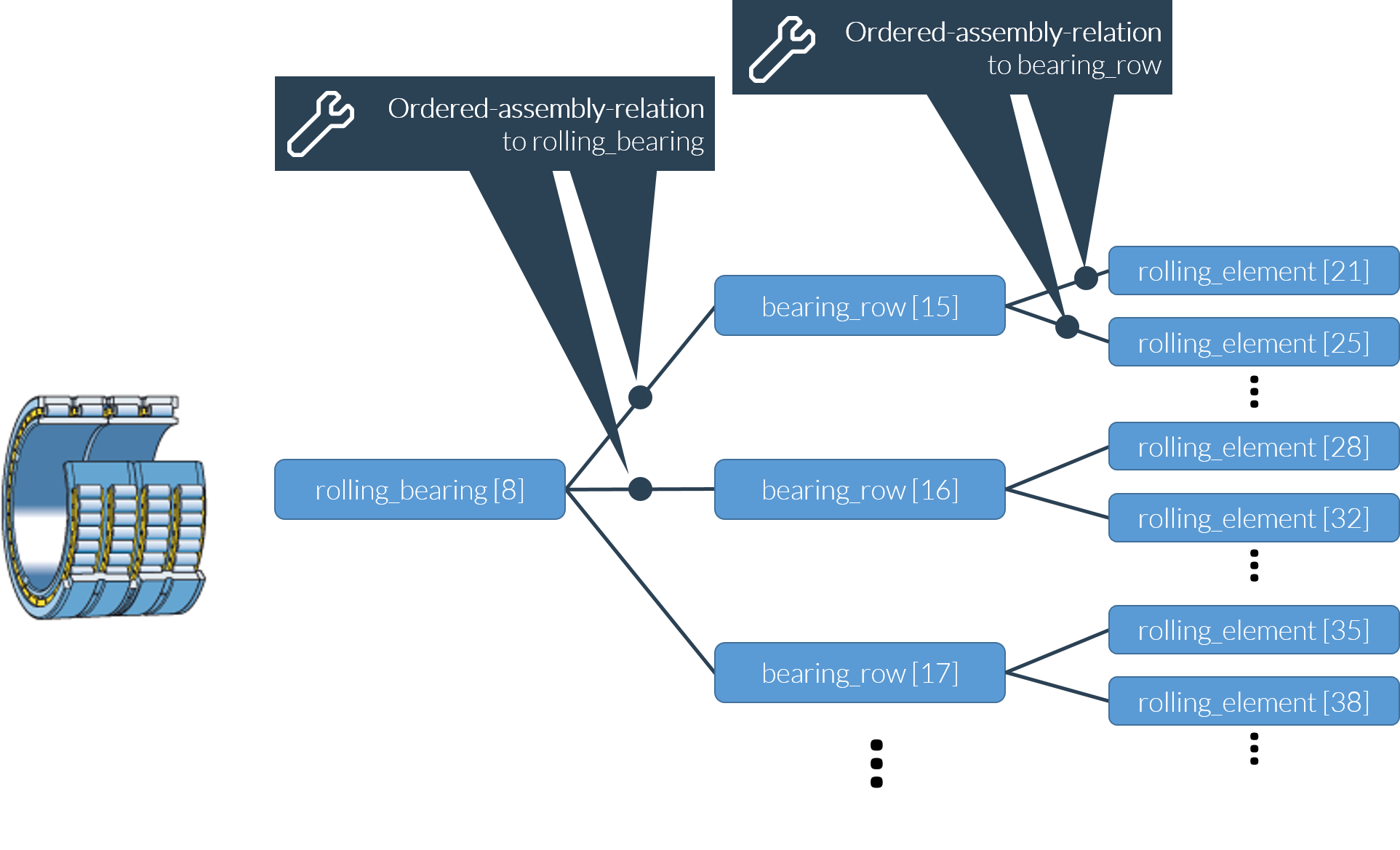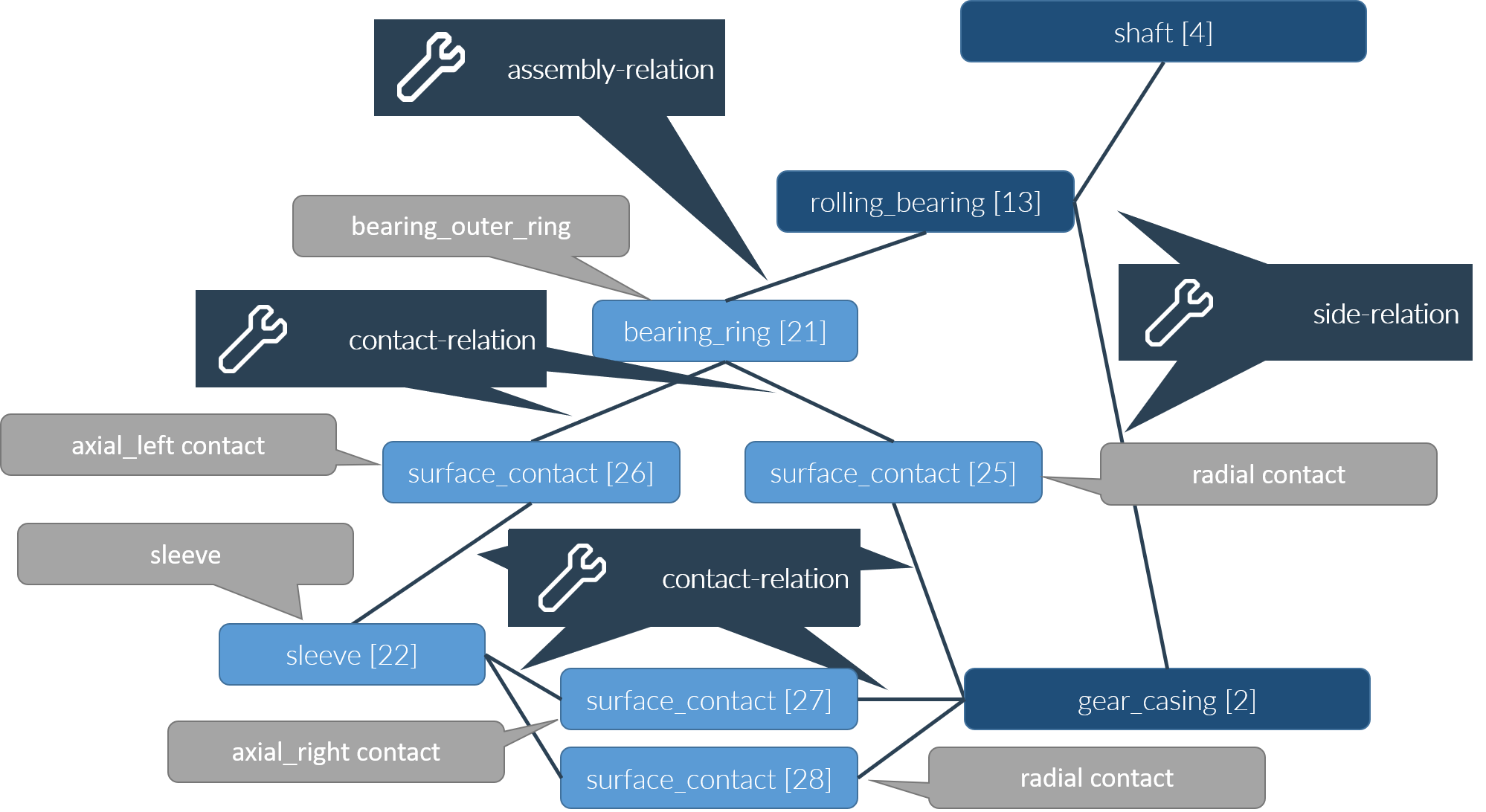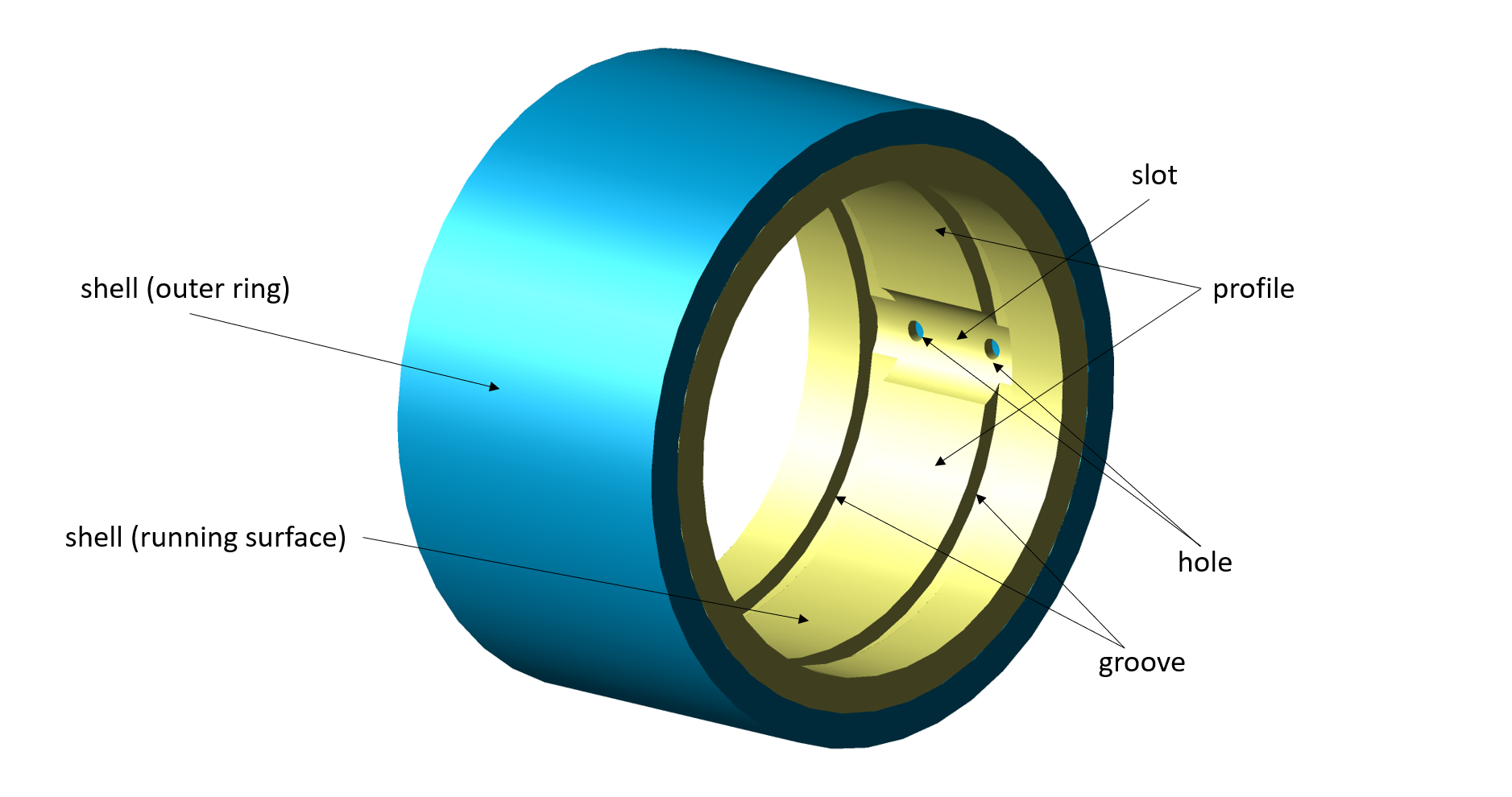Bearings
Bearings can be represented with various levels of detail. Abstract concept bearings are the most general form of a bearing. They include information about the position and rigidity of the bearing location. The conventions for construction and relations also apply to rolling bearings and plain bearings.
Connecting the bearing in the model
A bearing is connected with two components via a side relation. The role of the "inner_part“ refers to the component that is mounted to the inner diameter of the bearing. Similarly, the role of the "outer_part" refers to the component that is mounted to the outer diameter of the bearing.
If no specific inner and outer side can be identified (abstract concept bearings), the "inner_part"/"outer_part" roles can be defined arbitrarily; e.g., inner_part = left for axial connections.
Required components | XML syntax |
|---|---|
Bearings | <component id="12" type="concept_bearing"> ... </component> |
Two of the following component types are required, depending on the components that are connected by the coupling:
Optional components | XML syntax |
|---|---|
Shaft | <component id="15" type="shaft"> ... </component> |
Casing | <component id="2" type="gear_casing"> ... </component> |
Side plate | <component id="10" type="side_plate"> ... </component> |
Exactly one of the following relations is required, depending on the components that are connected by the bearing:
Required relations | XML syntax |
|---|---|
Side relation for shaft-in-shaft bearing arrangements | <relation id="16" type="side"> <ref id="12" role="assembly" hint="concept_bearing"/> <ref id="8" role="inner_part" hint="shaft"/> <ref id="20" role="outer_part" hint="shaft"/> </relation> |
Side relation for bearings within the casing | <relation id="18" type="side"> <ref id="12" role="assembly" hint="concept_bearing"/> <ref id="20" role="inner_part" hint="shaft"/> <ref id="2" role="outer_part" hint="gear_casing"/> </relation> |
Side relation for bearings on the casing journals | <relation id="18" type="side"> <ref id="12" role="assembly" hint="concept_bearing"/> <ref id="2" role="inner_part" hint="gear_casing"/> <ref id="20" role="outer_part" hint="shaft"/> </relation> |
Side relation for bearings in the side plate | <relation id="17" type="side"> <ref id="12" role="assembly" hint="concept_bearing"/> <ref id="8" role="inner_part" hint="shaft"/> <ref id="10" role="outer_part" hint="side_plate"/> <relation> |

Rolling bearings
A distinction is made between two types of rolling bearings:
For rolling_bearing_with_catalog_geometry components, the catalog information is either explicitly or implicitly (reference to catalog) specified.
For rolling_bearing_with_detailed_geometry components, the internal geometry of the bearing is either explicitly or implicitly (special file) specified.
A rolling bearing can be further detailed via a number of bearing rows, which in turn can contain a number of rolling elements. The components rolling bearing contact as well as the bearing ring and its surface contacts can be used to describe the contacts in the rolling bearing.
Bearing series and rolling elements
The bearing-to-bearing row and bearing row-to-rolling element associations are represented by ordered assembly relations.

Required components | XML syntax |
|---|---|
bearing_row 1 | <component id="15" type="bearing_row"> ... </component> |
... | ... |
bearing_row n | <component id="18" type="bearing_row"> ... </component> |
rolling_element 1 | <component id="21" type="rolling_element"> ... </component> |
... | ... |
rolling_element_m | <component id="40" type="rolling_element"> ... </component> |
Required components | XML syntax |
|---|---|
Side relation rolling_bearing – shaft – gear_casing | <relation id="1" type="side"> <ref id="8" role="assembly" hint="rolling_bearing"/> <ref id="3" role="inner_part" hint="shaft"/> <ref id="2" role="outer_part" hint="gear_casing"/> </relation> |
Ordered assembly relation rolling_bearing – bearing_row order 1 | <relation id="4" type="ordered_assembly" order="1"> <ref id="8" role="assembly" hint="rolling_bearing"/> <ref id="15" role="part" hint="bearing_row"/> </relation> |
Ordered assembly relation rolling_bearing – bearing_row order 2 | <relation id="5" type="ordered_assembly" order="2"> <ref id="8" role="assembly" hint="rolling_bearing"/> <ref id="16" role="part" hint="bearing_row"/> </relation> |
... | ... |
Ordered assembly relation bearing_row – rolling_element order 1 | <relation id="6" type="ordered_assembly" order="1"> <ref id="15" role="assembly" hint="bearing_row"/> <ref id="21" role="part" hint="rolling_element"/> </relation> |
Ordered assembly relation bearing_row – rolling_element order 2 | <relation id="7" type="ordered_assembly" order="2"> <ref id="15" role="assembly" hint="bearing_row"/> <ref id="22" role="part" hint="rolling_element"/> </relation> |
... | ... |
The attributes all_rows_are_identical for the bearing component and all_rolling_elements_are_identical for the bearing_row component included in REXS 1.0 have been removed. All bearing rows must always be explicitly modeled.
Clarification for specific bearing types:
Four-point contact ball bearings have one row of balls
Cross-roller bearings have two rows of rollers with different pressure angles, etc.
Rolling element contacts | rolling_element_contact
The rolling element contact component (rolling_element_contact) is used to represent the various contacts of a rolling element with the raceway and the rib. It is assigned to the rolling element via an assembly relation. Multiple contacts can be assigned to a rolling element. The contact partner of the rolling element is identified by the rolling_element_contact_type attribute of the rolling_element_contact.
Required components | XML syntax |
|---|---|
rolling_element | <component id="407" type="rolling_element"> ... </component> |
rolling_element_contact | <component id="708" type="rolling_element_contact"> ... </component> |
Required relations | XML syntax |
|---|---|
assembly | <relation id="350" type="assembly"> <ref id="407" role="assembly" hint="rolling_element"/> <ref id="708" role="part" hint="rolling_element_contact"/> </relation> |
Bearing rings, sleeves, and surface contacts
Bearing rings
Bearing rings (bearing_ring component type) can be explicitly modeled. This is particularly useful when a (different) material is to be assigned to the bearing rings, or if the contact of the bearing rings with the mounting parts (e.g., the housing) is to be described in greater detail. The properties of the surface contacts can be defined in the corresponding component (surface_contact component type). Furthermore, sleeves (sleeve component type) can also be considered as axial or radial intermediate elements.
The bearing ring (bearing_ring) is connected with the rolling bearing via an assembly relation. The "bearing_ring_type" attribute of the bearing ring component is used to identify the inner/outer ring of the bearing. A material can be assigned to the bearing ring via a reference relation.
Note
When should bearing rings be modeled as components?
Only if the details of the bearing ring are of interest; otherwise, it is sufficient to use the "has_inner_ring" and "has_outer_ring" attributes.
If, for example, "has_inner_ring"=false, the inner ring can not be modeled as a component .
Modeling Guideline Static Analysis
Even if the bearing rings and their contact with the mounting parts (shaft, casing, etc.) are modeled, the bearing must be connected to these components via a side relation, as usual.
There are 3 levels of detail available for describing the bearing rings (see "level_of_detail" attribute):
cylinder
contour (rotationally symmetrical)
free_geometry (e.g., CAD/FEM)
For the free_geometry detail level, an assembly_group can be assigned via a reference relation.
Required relations | XML syntax |
|---|---|
assembly | <relation id="450" type="assembly"> <ref id="300" role="assembly" hint="rolling_bearing"/> <ref id="808" role="part" hint="bearing_ring"/> </relation> |
reference | <relation id="451" type="reference"> <ref id="808" role="origin" hint="bearing_ring"/> <ref id="15" role="referenced" hint="material"/> </relation> |
reference | <relation id="452" type="reference"> <ref id="808" role="origin" hint="bearing_ring"/> <ref id="201" role="referenced" hint="assembly_group"/> </relation> |
Sleeves
The sleeve component is independent (cannot be assigned to other components via an assembly relation). As with the bearing ring, a material, the 3 levels of detail and, in the case of the free_geometry detail level, an assembly_group can be assigned to the sleeve via a reference relation.
Surface contact
The surface_contact component includes parameters that describe the contact in greater detail (e.g.; contact surface, contact force, etc.). The two contact partners and the surface contact component are connected via a contact relation. The type of surface contact (radial, axial left, axial right) is defined via the "type_of_surface_contact" attribute. With axial contact, "left"/"right" is relative to the contact partner with the role of "side_1."
Required relations | XML syntax |
|---|---|
assembly | <relation id="500" type="contact"> <ref id="807" role="assembly" hint="surface_contact"/> <ref id="808" role="side_1" hint="bearing_ring"/> <ref id="2" role="side_2" hint="gear_casing"/> </relation> |
Example
The following example shows a bearing outer ring that is radially located in the housing and is axially supported on a sleeve.

Plain bearings
The following section describes the modeling of hydrodynamic radial plain bearings (also called journal bearings). Hydrodynamic axial plain bearings as well as non-lubricated plain bearings, bushings, etc. are not yet defined in REXS and can currently only be approximated as a concept_bearing.
Notice
Change from REXS version 1.5
Modeling of Hydrodynamic radial plain bearings - hydrodynamic_radial_plain_bearing is new.
Hydrodynamic radial plain bearings - hydrodynamic_radial_plain_bearing
Hydrodynamic fixed segment bearings (hydrodynamic_radial_plain_bearing) can be modeled in detail in REXS. Parametric and grid-based description of multiple profiles, any number of profile modifications (slots, grooves, holes), as well as multi-part plain bearing shells are supported. Both conventional plain bearings (rotating journals, stationary bearing shell) as well as planetary plain bearings can be described. Tilting pad bearings are not yet supported.

As with all bearings, the plain bearing is connected with its mounting parts on the inner and outer side via the side relation.
The inner structure of the plain bearing is now described in greater detail:
The bearing can be assigned 0-x plain bearing shells (radial_plain_bearing_shell) via an ordered_assembly relation (from inside to outside)
The bearing can be assigned 0-x plain bearing profiles (radial_plain_bearing_profile) via an assembly relation. The "lubricant_side" attribute is used to specify whether the inside or outside of the lubricating gap is described.
The bearing can be assigned 0-x slots (hydrostatic pockets) (radial_plain_bearing_slot), plain bearing grooves (radial_plain_bearing_groove), and plain bearing holes (radial_plain_bearing_hole) via an assembly relation. The "lubricant_side" attribute is used to specify whether the inside or outside of the lubricating gap is described.
The bearing can be assigned a lubricant via a reference relation.
A plain bearing shell can be assigned a material via a reference relation.
A plain bearing profile can either be described using parameters or linked to a point_list via an assembly relation. A plain bearing profile data set (radial_plain_bearing_profile_data_set), which contains a local change to the diameter clearance for each point, can be assigned to the point list via a reference relation.
Example model - XML syntax
Example model | XML syntax
<?xml version="1.0" encoding="UTF-8" standalone="no"?>
<model applicationId="FVA Workbench" applicationVersion="9.0" date="2023-12-06T13:52:44+01:00" version="1.6">
<relations>
...
<relation id="8" type="side">
<ref id="2" role="outer_part" hint="Casing [2]"/>
<ref id="3" role="inner_part" hint="Shaft [3]"/>
<ref id="5" role="assembly" hint="Plain bearing [5]"/>
</relation>
<relation id="12" type="reference">
<ref id="5" role="origin" hint="hydrodynamic_radial_plain_bearing"/>
<ref id="6" role="referenced" hint="lubricant"/>
</relation>
<relation id="13" type="ordered_assembly" order="1">
<ref id="5" role="assembly" hint="hydrodynamic_radial_plain_bearing"/>
<ref id="16" role="part" hint="radial_plain_bearing_shell"/>
</relation>
<relation id="14" type="reference">
<ref id="16" role="origin" hint="radial_plain_bearing_shell"/>
<ref id="9" role="referenced" hint="material"/>
</relation>
<relation id="15" type="ordered_assembly" order="2">
<ref id="5" role="assembly" hint="hydrodynamic_radial_plain_bearing"/>
<ref id="17" role="part" hint="radial_plain_bearing_shell"/>
</relation>
<relation id="16" type="reference">
<ref id="17" role="origin" hint="radial_plain_bearing_shell"/>
<ref id="8" role="referenced" hint="material"/>
</relation>
<relation id="17" type="assembly">
<ref id="5" role="assembly" hint="hydrodynamic_radial_plain_bearing"/>
<ref id="18" role="part" hint="radial_plain_bearing_profile"/>
</relation>
<relation id="18" type="assembly">
<ref id="5" role="assembly" hint="hydrodynamic_radial_plain_bearing"/>
<ref id="19" role="part" hint="radial_plain_bearing_profile"/>
</relation>
<relation id="19" type="assembly">
<ref id="5" role="assembly" hint="hydrodynamic_radial_plain_bearing"/>
<ref id="20" role="part" hint="radial_plain_bearing_slot"/>
</relation>
<relation id="20" type="assembly">
<ref id="5" role="assembly" hint="hydrodynamic_radial_plain_bearing"/>
<ref id="21" role="part" hint="radial_plain_bearing_slot"/>
</relation>
...
</relations>
<components>
...
<component id="5" type="hydrodynamic_radial_plain_bearing" name="Plain bearing [5]">
<attribute id="ambient_pressure_plain_bearing" unit="N / mm^2">0.1</attribute>
<attribute id="feed_pressure_plain_bearing" unit="N / mm^2">0.15000000000000002</attribute>
<attribute id="inner_diameter" unit="mm">120.0</attribute>
<attribute id="is_isothermal_calculation" unit="none">true</attribute>
<attribute id="mounting_angle_plain_bearing" unit="deg">-35.0</attribute>
<attribute id="outer_diameter" unit="mm">250.0</attribute>
<attribute id="reference_component_for_position" unit="none">1</attribute>
<attribute id="reference_diameter_relative_clearance_plain_bearing" unit="mm">120.0</attribute>
<attribute id="relative_clearance_plain_bearing" unit="%">0.215</attribute>
<attribute id="u_coordinate_on_shaft_inner_side" unit="mm">60.0</attribute>
<attribute id="u_coordinate_on_shaft_outer_side" unit="mm">60.0</attribute>
<attribute id="width" unit="mm">90.0</attribute>
</component>
<component id="16" type="radial_plain_bearing_shell" name="Running surface Plain bearing [5]">
<attribute id="inner_diameter" unit="mm">120.0</attribute>
<attribute id="lubricant_side" unit="none">outer_side</attribute>
<attribute id="outer_diameter" unit="mm">122.0</attribute>
</component>
<component id="17" type="radial_plain_bearing_shell" name="Shell Plain bearing [5]">
<attribute id="inner_diameter" unit="mm">122.0</attribute>
<attribute id="lubricant_side" unit="none">outer_side</attribute>
<attribute id="outer_diameter" unit="mm">250.0</attribute>
</component>
<component id="18" type="radial_plain_bearing_profile" name="Profile Plain bearing [5]">
<attribute id="angular_position_center_of_curvatue" unit="deg">90.0</attribute>
<attribute id="end_angle_plain_bearing_feature" unit="deg">270.0</attribute>
<attribute id="lubricant_side" unit="none">outer_side</attribute>
<attribute id="profiling_plain_bearing" unit="none">1.42</attribute>
<attribute id="starting_angle_plain_bearing_feature" unit="deg">90.0</attribute>
</component>
...
<component id="20" type="radial_plain_bearing_slot" name="Slot Plain bearing [5]">
<attribute id="axial_position_of_plain_bearing_feature" unit="mm">-36.0</attribute>
<attribute id="end_angle_plain_bearing_feature" unit="deg">120.0</attribute>
<attribute id="fill_ratio_plain_bearing_feature" unit="none">1.0</attribute>
<attribute id="is_pressurized" unit="none">true</attribute>
<attribute id="lubricant_side" unit="none">outer_side</attribute>
<attribute id="starting_angle_plain_bearing_feature" unit="deg">90.0</attribute>
<attribute id="width" unit="mm">72.0</attribute>
</component>
...
</components>
</model>